There are many types of diseases that occur in potato crops. Sometimes the attack of some potato diseases is very severe, if they are not managed on time, they cause great damage to the crop. Here we will know about some of the major potato diseases in detail as follows:
Potato blight
Potato blight is caused by fungi. There are two types of potato blight disease.
- Early blight of potato
- Late blight of potato
Early blight of potato
Early blight of potato is caused by a fungus called Alternaria solani. This disease is found in the whole country wherever potato is grown. This disease affects the leaves and tubers of plants.
The initial symptoms of the disease appear on the older lower leaves. Small circular (1-2 mm) and oval brown spots are formed on the leaves, later as the disease progresses, these spots increase to oval brown color, due to which the leaves of the plant appear scorched.
The lesions on the leaves appear dry and papery. If the diseased leaves are looked at, in the direction of sunlight, light-colored ring-like structures are seen inside the spots.
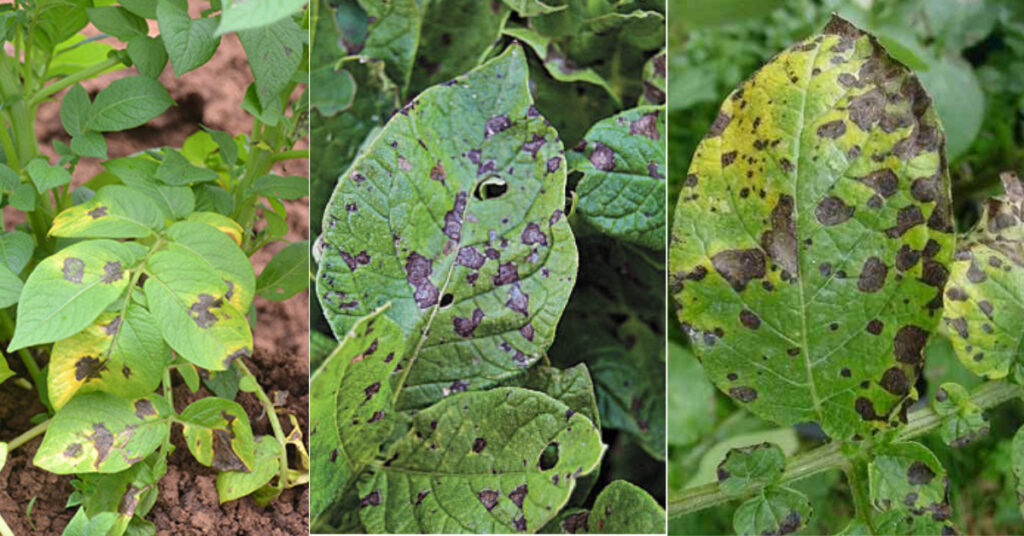
Management/control
- Always use disease-free, healthy tubers for sowing.
- Before sowing the potato crop, burn the crop residue from the field and destroy it.
- To protect potato crop from blight, use a balanced amount of fertilizers, especially nitrogen fertilizers.
- Two sprays of Urea (1.0%) solution at an interval of 8-10 days after 45 days of sowing helps to protect the crop from severe attack of early blight.
- For the control of blight disease, 2-3 sprays of Dithane-M 45 (Mineb) or Mancozeb should be given at an interval of 10 days.
- Spraying of Copper oxychloride (0.30%) and Bordeaux mixture (1.0%) should be done to prevent early blight in hilly areas.
Late blight of potato
Late blight of potato is caused by a fungus called Phytophthora infestans. This disease affects the leaves and stems of plants, as the disease progresses, its effect reaches the tubers. In case of excessive outbreak of late blight, the whole plant gets scorched. In Uttar Pradesh, most of the crop losses are due to late blight.
Light green or purple spots are first formed on the leaves of plants affected by this disease. As the disease progresses, the spots increase in size and the affected leaves appear blistered as if scorched by hot water and eventually rot and dry up. When dried, the leaves appear brown or black in color.
If the leaves affected with late blight are observed carefully, a white or light-colored cotton-like growth (structure) of the fungus is visible just below the dead spots on the lower surface of the leaves.
The stems of the plants affected by the disease start turning black at the ends (top). Light brown lesions are formed on the stem which may encircle the stem.
Due to excessive infestation of the disease, all the leaves and stems of the plants rot and dry up and the plants die. Reddish-brown spots appear on the skin and flesh of the affected tubers.
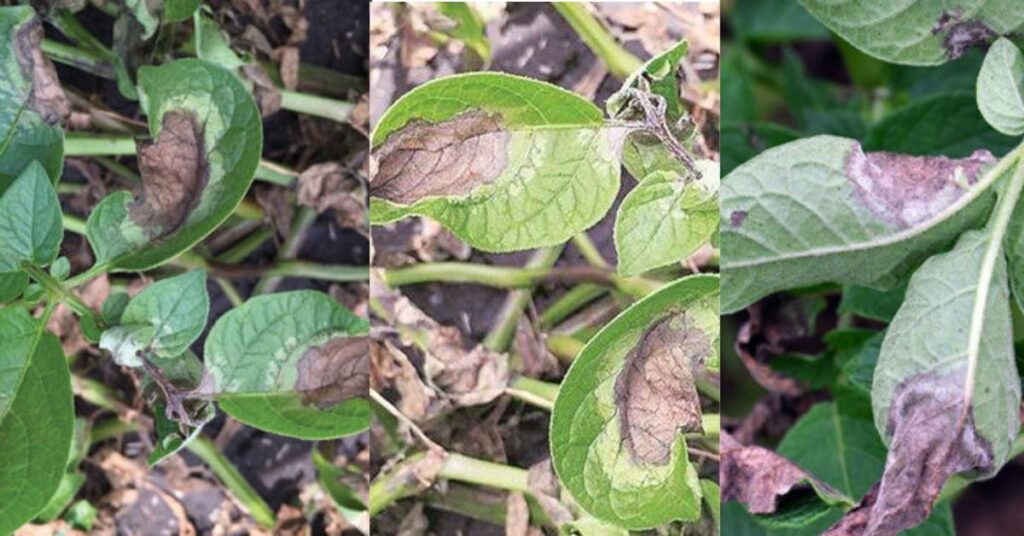
Management/control
- Tubers obtained from diseased plants are the main carriers of the pathogen. Plants appear completely healthy when infected tubers are sown, but if favorable conditions are met, the plants get diseased, so always sow disease-free and healthy seeds.
- If the weather conditions (temperature 10-12℃, RH>80%) are favorable for the spread of the disease, then no irrigation should be done, if very necessary, light irrigation should be done.
- If more than 75% of the leaves have been affected by late blight, then the diseased green part should be cut from above the ground level so that the disease does not reach the tubers.
- Spraying of Mancozeb is effective before disease occurs.
- If necessary, the spray of Mancozeb can be repeated at 8-10 day intervals.
- In case of severe attack of late blight, one or two sprays of Metalaxyl (0.25%) should be given to check the further progression of the disease.
Septoria leaf spot
This disease is caused by a fungus called Septoria lycopersici. Symptoms of this disease first appear on the lower leaves and then gradually spread to the upper leaves. In this disease, small circular, gray center with dark brown margin spots are formed on the underside of the leaves.
Later on, as the disease progresses, the spots enlarge and coalesce and a black dot appears in the center of the spots. Sometimes the symptoms of the disease also appear on the stem and blossoms but are rarely seen on the fruits.
The symptoms of the disease on the stem and flowers are similar to that of the leaves. In case of severe infestation of disease, the leaves turn yellow and fall off.
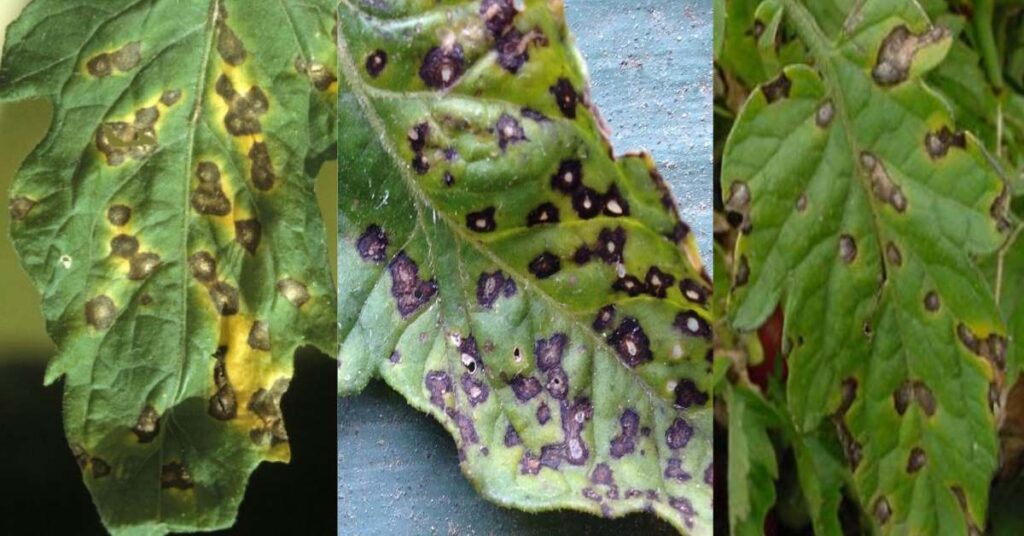
Management/control
Spraying of Mineb, Mancozeb, Chlorothalonil should be done to effectively prevent Septoria leaf blight disease. If required, spraying of above mentioned chemicals can be repeated at an interval of 8-10 days.
Common scab
Common scab of potato is caused by Streptomyces scabies. This disease affects the surface of potato tubers. This disease causes cork-like lesions on the surface of tubers. Affected tubers have rough, cracked skin with raised scab-like spots.

Management/control
- Sow only disease-free and healthy tubers and sow after treating the tubers.
- Maintaining adequate moisture in the ridges at the early stage of tuber formation prevents disease development to an extent.
- Follow suitable crop rotation.
- No effective chemical treatment is available.
Black scurf and stem canker
This disease is caused by a fungus called Rhizoctonia solani. This disease affects the stems, tubers, sprouts and stolons of the plants. In this disease, chocolate-colored, hard and raised spots are formed on the surface of potato tubers. These spots do not get removed by washing with water but they get removed by rubbing with the nail.
This disease often damages the sprouts of stored tubers and field sown tubers. Severely infected sprouts are unable to emerge from the soil and die inside the soil.
Sometimes small green and reddish tubers also formed on the axils of diseased plants. The infection of this disease also spreads to the roots, due to which the cortical tissue of the developing stolons also rots.
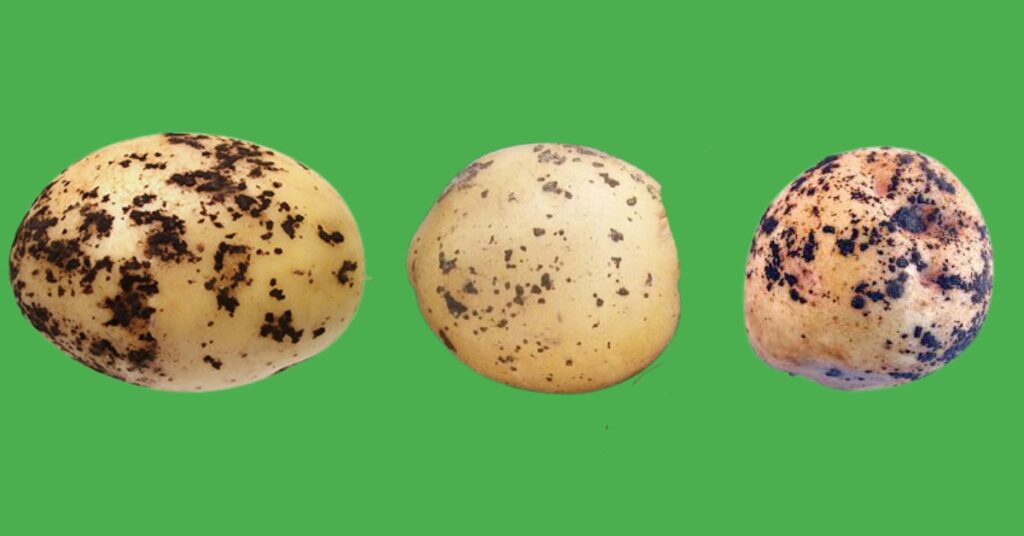
Management/control
Treating tubers with 1% acetic acid + 0.5% zinc sulfate or carbendazim or boric acid can effectively prevent disease.
Potato mosaic
It is a viral disease. In this disease, many types of symptoms are seen on the leaves.
- Leaves become smaller.
- Greenish-yellow spots are seen on the leaves.
- The size of the tubers is also reduced.
Management/control
Healthy and treated seeds should be sown. Often, this disease is transmitted by aphids, so to protect the crop from aphids, spraying of imidacloprid should be done.
Potato Spindle Tuber Viroid (PSTVd)
As the name suggests it is a viroid disease. Due to this disease, the leaves of the plants become small and turn downwards. Plant growth may be stunted. Affected plants may have relatively more branches.
Tubers become short, spindle or oblong, cylindrical or more rounded than expected for a particular variety and have prominent eyes evenly distributed over the tuber. Tubers may crack or a knob-like structure may form on the tuber.

Management/control
- Uproot and throw away infected plants.
- Sow infection-free seeds (tubers).
- There is no chemical or biological treatment available to control this disease.
Potato wart disease
Potato wart disease is caused by a fungus called Synchytrium endobioticum. Chances of spreading this disease are more in cold weather and more moist soil, where there is no proper drainage and soil aeration management.
In this disease, a cauliflower-like wart is formed on the tubers, stolons and on the base of the stem of potatoes. It is not necessary that the wart develops on all the tubers of the diseased plant. One or more warts may develop on diseased tubers. The color of tuber warts may change from brown to black over time.

Management/control
- Sow disease-free and healthy seeds.
- Adopt long crop rotation (5 years or more).
- There is no effective chemical treatment available.
Black heart of potato
Black heart of potato is caused by lack of Oxygen. Basically, It is a disorder not a disease. It can be due to the following reasons-
- Due to not getting enough oxygen during early development of tubers.
- Due to waterlogging in the field or due to prolonged drought in the field.
- Due to not getting enough oxygen in the cold storage.
Symptoms

- The center of the potato tuber turns blackish.
- Large-size tubers are mostly affected by this disorder.
- Tuber tissues die from the inside.
- Later, the affected tubers rot but do not smell after rot.
Management
- Maintain proper aeration in the soil.
- To maintain proper aeration in the soil, the physical, chemical and biological condition of the soil should be improved.
- Irrigate the field at proper time.
- To avoid waterlogging in the field, make proper arrangements for drainage.
- Make proper arrangements for aeration in the storage house (cold store).
Note: Any recommendations regarding the use of chemicals are for informational purposes only. Before using any type of chemical for weed, disease and pest control, consult the nearest agriculture shop or a local agricultural consultant.
How helpful was this post for you, tell me in the comment box and you can also give us your advice, your comment and advice are very important for us.
Thank you..!
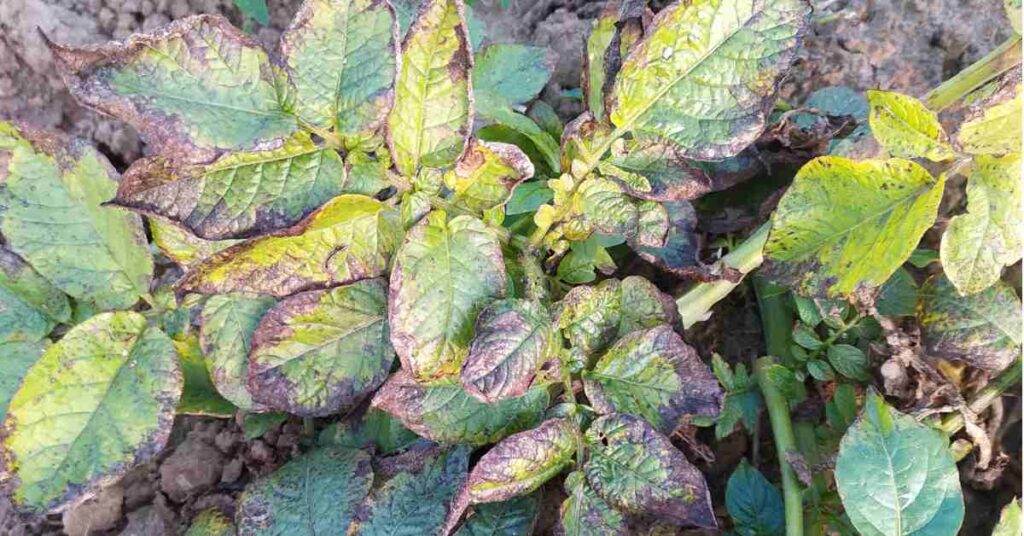
Kavach CN M-45 or Ridomil gold